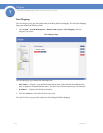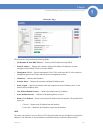
129
Chapter 7:
SFE2000/SFE2000P Gigabit Ethernet Switch Reference Guide
Chapter
7
Configuring Layer 3
In Layer 3 mode, multiple IP addresses can be configured on ports, LAGs or VLANS. This provides
greater network flexibility than Layer 2 mode where only a single IP address is configured on ports,
LAGs or VLANs. A predefined Default Gateway is not provided in Layer 3. To manage the device
remotely, a default route is defined. The Default Route is the route with the next hop of 0.0.0.0. The
Default Route is defined in the IP Routing Page.
This section provides information for configuring Layer 3 features, and includes the following topics:
• Configuring IP Addressing
• Defining IP Routing
Configuring IP Addressing
The IP Addressing subsection contains the following pages:
• IP Interface
•ARP Proxy
• UDP Relay
• DHCP Relay
•ARP
IP Interface
The IP Interface Page contains fields for assigning IP addresses. Packets are forwarded to the default IP
when frames are sent to a remote network. The configured IP address must belong to the same IP address
subnet of one of the IP interfaces.
1. Click System > System Management > IP Addressing > IP Interface. The IP Interface Page
opens:


















